Jewish Memorial at Dachau The Jewish Memorial, designed by Frankfurt architect Hermann Zwi Guttmann, is located approximately 40 yards east of the Catholic Memorial in the area of the former Dachau concentration camp. The building is made out of basalt lava and the floor of the prayer room is six feet underground. The 18-foot walkway leading down to the underground room is outlined by an iron fence which is reminiscent of the barbed wire fence around the concentration camp. Like the Catholic chapel next to it, the Jewish Memorial is open to the elements and has a hole at the apex of the roof from which a marble shaft protrudes. The shaft is topped by a Menorah with seven arms, representing the holy relic of Jerusalem's ancient temple. 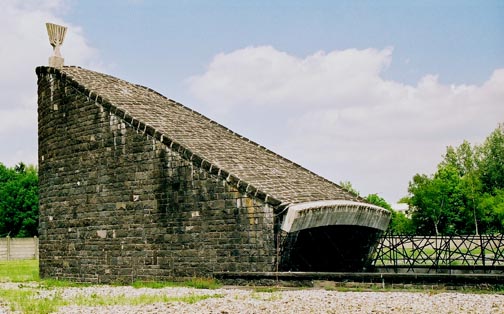 Dr. Johannes Neuhäusler, a former inmate of Dachau who was instrumental in getting the Catholic Memorial and the Catholic Convent built at Dachau, suggested that a Jewish Memorial be built. Construction began in September 1964 and the completed memorial was dedicated on May 7, 1967. The photo below shows the close proximity of the Jewish Memorial to the Catholic Convent. 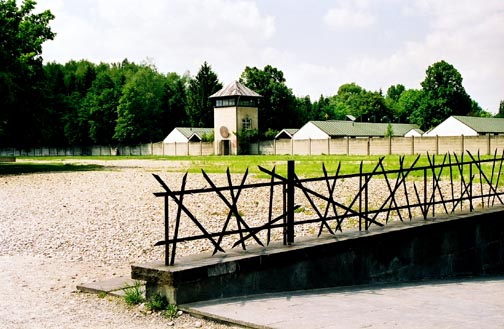 The location of the Jewish Memorial is close to where the original disinfection hut once stood. The disinfection hut, first used as a facility to kill lice in the camp clothing, had been converted into a restaurant during the time that the camp was the home of German refugees; it was torn down in November 1963 to make way for the construction of the Jewish Memorial. In 1964, the 34 barracks buildings were also torn down, along with a building which formerly housed the camp brothel, located very close to the spot where the Jewish Memorial now stands. The photograph above shows the Jewish Memorial in the northeast corner of the former camp. On the left, you can see a the Carmelite Convent which is located just outside the camp. The photograph below shows the rear view of the Jewish Memorial. The line of poplar trees to the left marks the main camp road which leads from the International Monument to the Catholic Church of the Mortal Agony of Christ. On the right in this photograph, you can see a bit of the Catholic chapel which is covered with river rock and surrounded by a ring of dwarf oak trees. The gravel around the Jewish Memorial is very coarse and you will need sturdy walking shoes to traverse this area. 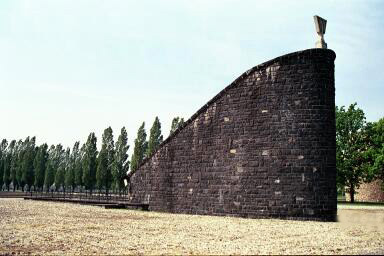 The area directly behind where the Jewish Memorial stands today was formerly the site of the rabbit hutches when the concentration camp was in operation. The rabbits were raised to provide fur for the clothes worn by German pilots. When Heinrich Himmler came to visit the camp, he brought along his small daughter, Gudrun, and took her to visit the rabbits. In front of the Jewish Memorial is the east side of the former camp with rectangular beds of gravel to denote where the buildings formerly stood. In the photograph below, you can see two of the seven guard towers and the east wing of the service building in the background. In the foreground is the tiled ramp that leads down into the interior of the memorial. 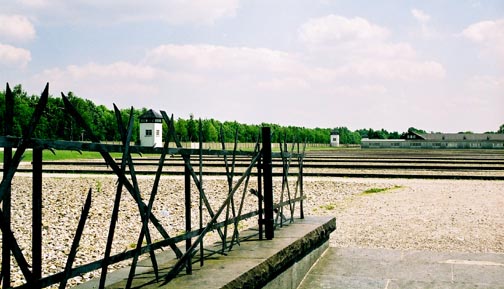 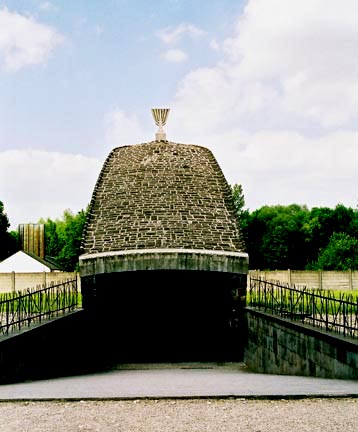 When I first saw the Jewish Memorial, I thought it was supposed to represent the ovens where the bodies of the Jews were burned, or perhaps the underground gas chambers at Auschwitz. The photo above is reminiscent of the Dachau ovens. According to the architect, however, the underground room represents the hiding places of the Jews who tried to escape persecution by the Nazis. There were 10,000 German Jews in Berlin who managed to hide from the Nazis throughout the war. Like the Protestant Memorial which is also partially underground, the Jewish Memorial represents hope and salvation, after descending to the depths of despair. At the bottom of the ramp, there is an iron gate across the entrance, shown in the photograph below. It reminds me of the "Arbeit Macht Frei" gate into the former concentration camp, except that the bars of the gate are chaotic and instead of the cynical Nazi slogan, there is a star of David on each side of the gate. Over the gate (not shown) is an inscription in Hebrew which reads "Give them a sign of warning, eternal one! The peoples should learn that they are mortals." 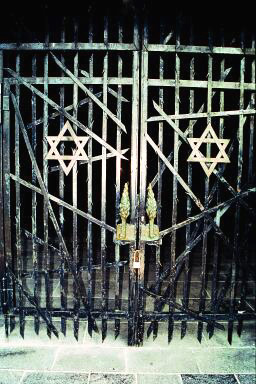 The door handles were fashioned to resemble olive branches, which are the sign of God's reconciliation with Noah after the flood. Notice that the handles are the same on both sides of the door, as the photograph below shows. The door was closed and locked on the day that I took this picture, although the Memorial is usually open to the public. I had to return the next day to get interior shots of the Memorial. 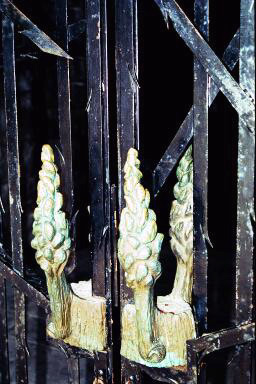 Interior of Jewish MemorialBack to Memorial SiteBack to Table of ContentsHome |